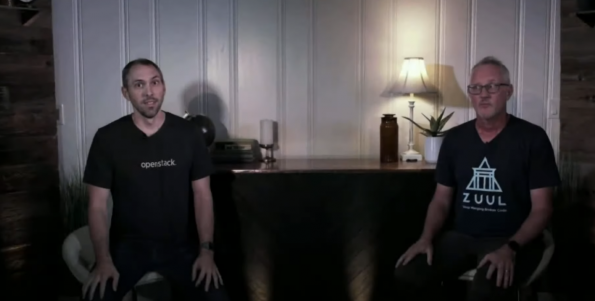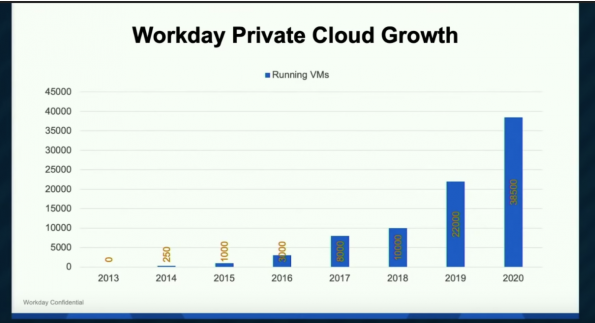Last week, thousands of community members participated in the Open Infrastructure Summit. This time, the commute for over 10,000 attendees was short, because just like every other 2020 conference, the Summit was virtual. Hosted by the Open Infrastructure Foundation (previously the OpenStack Foundation (OSF)—if you missed this announcement, check out the news), the Summit gathered people from over 120 countries and 30 different open source communities to collaborate around the next decade of open infrastructure.
The hallway track and networking activities were missed, but the week was still full of announcements and new (and growing!) users sharing their open source, production use cases. The event was free to participate, and this was only possible with the support of the Summit sponsors:
Headline: Canonical (ubuntu), Huawei, VEXXHOST
Premier: Cisco, Tencent Cloud
Exhibitor: InMotion Hosting, Mirantis, Red Hat, Trilio, VanillaStack, ZTE
Below is a snapshot of what you missed and what you may want to rewatch.
Like I mentioned earlier, the OSF opened the Summit with some big news. Jonathan Bryce, executive director, announced the Open Infrastructure Foundation (OIF) as the successor to the OSF during the opening keynotes on Monday, October 19. With support from over 60 founding members and 105,000 community members, the OIF remains focused on building open source communities to build software that runs in production. Bryce was joined by Mark Collier, OIF COO, who announced that the OIF board of directors approved four new Platinum Members (a record number of new Platinum Members approved at one time): Ant Group, Facebook Connectivity, FiberHome, and Wind River.
The OIF builds open source communities who write software that runs in production.The OpenStack and Kata Containers communities celebrated software releases, and dozens users shared their open infrastructure production use cases.
Five days before the Summit, the OpenStack community released its 22nd version, Victoria. In Tuesday’s keynote, Kendall Nelson, chair of the First Contact SIG, talked about some of the features that landed including Ironic features for a smaller standalone footprint and supporting more systems at the edge. There were also features around hardware enablement and supporting FPGAs that she says will continue through the Wallaby cycle, which the upstream developers are discussing at the Project Teams Gathering (PTG) this week.
Right in time for the Summit, the Kata Containers community released its 2.0 version, including a rewrite of the Kata Containers agent to help reduce the attack surface and reduce memory overhead. The agent was rewritten in Rust, and users will see a 10x improvement in size, from 11MB to 300KB. Xu Wang, a member of the Kata Architecture Committee, joined the keynotes on Monday to talk about how Kata 2.0 is already running in production at Ant Group, home of the largest payment processor in the world as well as other financial services. At Ant Group, Kata Containers is running on thousands of nodes and over 10,000 CPU cores.
Ant Group is one of many users who shared information around their production use cases. Below are some highlights of the users who spoke. You can now watch all of the breakout and keynote sessions, and there will also be some Forum sessions uploaded in the coming days.
Production use cases:
The OIF announced its newest open infrastructure pilot project, OpenInfra Labs, a collaboration among universities and vendors to integrate and optimize open source projects in production environments and publish complete, reproducible stacks for existing and emerging workloads. Michael Daitzman, a contributor to the project, delivered a keynote introducing the project, thanking the community for their work with projects like OpenStack, Kubernetes, and Ceph, and inviting new contributors to get involved.
Magma, an open source mobile packet core project initiated by Facebook Connectivity, was front and center at the Summit last week. In the opening keynotes, Amar Padmanabhan, engineer at Facebook, introduced Magma and shared the community’s mission to bridge the digital divide and connect the next billion people to the Internet. The project was further discussed in a production use case from Mariel Triggs, the CEO of MuralNet, who talked about the connectivity issues that indigneous nations face and how her organization leverages Magma for an affordable way to keep them connected. Boris Renski, founder and CEO of FreedomFi, returned to the Summit keynote stage to show that building an LTE network with Magma is so easy, even a goat could learn to do it. And sure enough, the goat successfully deployed the network. I’m pretty sure the looks on these faces sum it all up.

Announced a few weeks ago, Verizon is running Wind River’s distribution of StarlingX in production for its 5G virtualized RAN. During Tuesday’s keynote, Ildiko Vancsa talked about their use case and why Verizon relies on StarlingX for ultra low latency, high availability, and zero-touch automated management.
Over 15 million compute cores are managed by OpenStack around the world. Imtiaz Chowdhury, cloud architect at Workday, talked about how their deployment has contributed to that growth with their own 400,000 core OpenStack deployment.

Additional OpenStack users talking about their production use cases include:
-
- CERN shared their OpenStack journey from 0 to 300,000 cores and how their resource management and deployment model changed completely: from virtualization and server consolidation to a cloud infrastructure and from bare metal to virtual machines to managed bare metal to containers. Belmiro Moreira also shared some of the challenges like leveraging container orchestration to deploy the OpenStack control plane and how they collaborated with the community to get where they are today.
- China Mobile showcased the automated hardware integration system its team built for its NFV cloud project and explain how 50,000 servers have been implemented with plug-and-play.
- GE Digital presented the tools, described the migration procedure, and highlighted the biggest challenges in upgrading from OpenStack Newton to Queens with minimal downtime.
- Société Générale, one of the top three French banks and a founding silver member of the OIF, talked about how they provide cloud services in multiple availability zones using a single OpenStack deployment.
- The European Weather Cloud, a joint project between the European Centre for Medium-Range Weather Forecasts (ECMWF) and the European Organisation for the Exploitation of Meteorological Satellites (EUMETSAT), shared their infrastructure architecture which is based 100% on open source software: OpenStack (Ussuri) and Ceph (Nautilus).
Volvo Cars shared their Zuul production use case to kick off the second day of Summit keynotes. Johannes Foufas and Albin Vass talked about how premium cars need premium tools, and Zuul is a premium tool. The team uses Zuul to build several software components including autonomous driving software, and Foufas says speculative merge and the prioritized queue system are two Zuul features their team relies on.
SK Telecom 5GX Labs won the 2020 Superuser Awards for their open infrastructure use case integrating multiple open source components in production, including Airship, Ceph, Kubernetes, and multiple components of OpenStack.
This was the first year the Superuser Awards ceremony was only held once, and there were eight organizations who shared production open infrastructure use cases that were reviewed by the community and advisors to determine the winner.
Learn how the 2020 Superuser Awards nominees are powering their organization’s infrastructure with open source in production:
If you missed any of the above sessions or announcements, check out the Open Infrastructure Foundation YouTube channel. Then, join the global Open Infrastructure community, and share your own personal open source story using #WeAreOpenInfra on social media.
- Revolution in Cloud Economy: How FishOS – Integrated Solution Reduced Enterprise’s Cloud Costs by 50% - July 1, 2024
- Inside Open Infrastructure: June 2024 - June 18, 2024
- 2024 Superuser Awards Nominations Now Open - June 9, 2024

)








